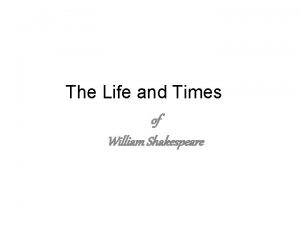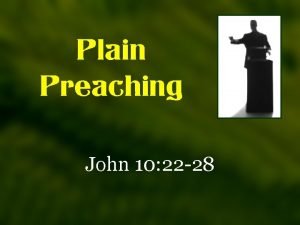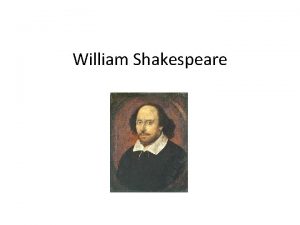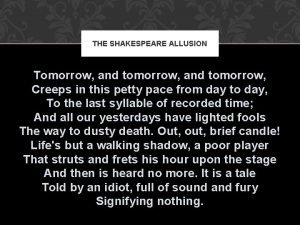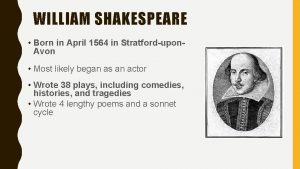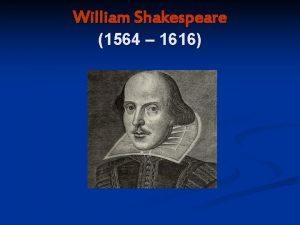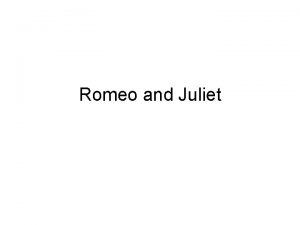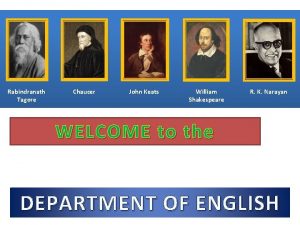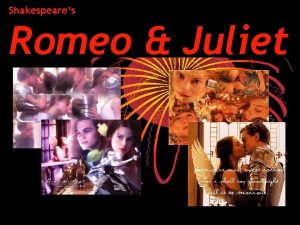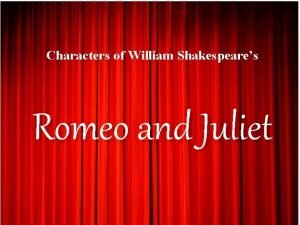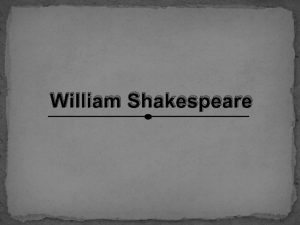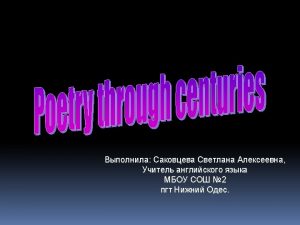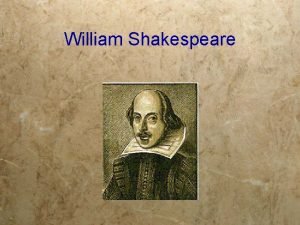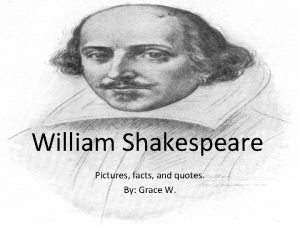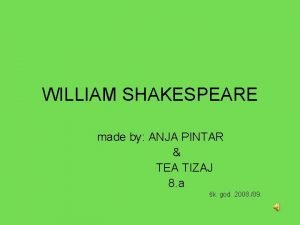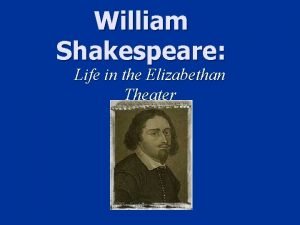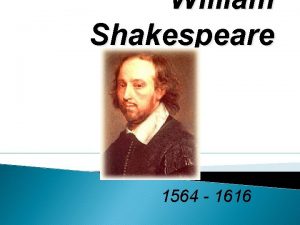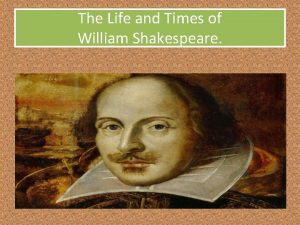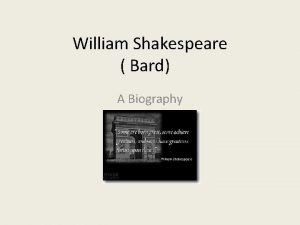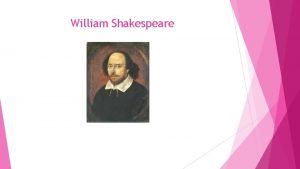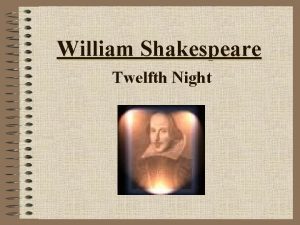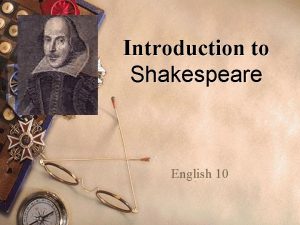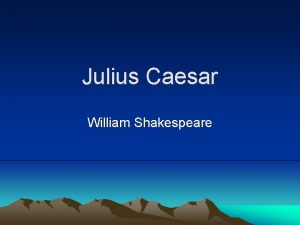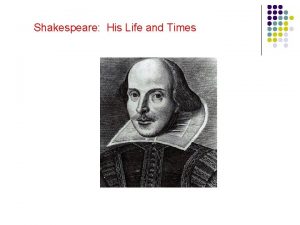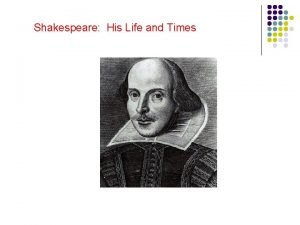The Life and Times of William Shakespeare Let
























- Slides: 24

The Life and Times of William Shakespeare

Let me introduce…Will

The Bard • William Shakespeare is generally thought to be one of the best playwrights of all times. • His works explore universal problems and emotions. • In addition, his characters show an astonishing understanding of human nature.

A Mysterious Man • Shakespeare’s plays, even four hundred years later, are familiar to lovers of literature worldwide. But many of the most basic facts of his life are unknown. • He remains a mysterious figure with regards to personal history. There are just two primary sources of information on the Bard: his works, and various legal and church documents that have survived from Elizabethan times.

Biography • Born~ April 23, 1564 (based on baptism) in Stratford. Upon-Avon (small town in England) • Baptized at the Holy Trinity Church on April 26, 1564. • Third of eight children

Schooling Shakespeare attended the free grammar school in Stratford. He never proceeded to university schooling.

Family Tree • Shakespeare married Anne Hathaway on November 28, 1582 • William was 18 when he got married; Anne was eight years older than him. • 1 st daughter: Susanna-born May 25, 1583 • They had a set of twins: Hamnet and Judith- born February 2, 1585. • Hamnet died in early childhood at the age of 11, on August 11, 1596.

The Lost Years • Disappears for seven years from all records • Rumors: – – Soldier Sailor Traveled Italy School Master • Estimated arrival in London-around 1588 (began to establish himself as an actor and playwright)

Shakespeare wrote: Comedies Histories Tragedies • He wrote 37 plays • 154 sonnets

Death • He wrote his will in 1611 • He died on April 23, 1616 Even in death, he leaves a final piece of verse as his epitaph: Good friend for Jesus’ sake forbear, To dig the dust enclosed here! Blessed be the man that spares these stones, And cursed be he who moves these bones.

Elizabethan Era • Good and evil; nothing in between: If something bad happened, it was a sign that God was punishing them. • The church and its leaders were representatives of God on Earth. • The king was king because God intended him to be and everyone else existed at lower social levels. • London grew 400% in population during this time, because of this, sanitation was lacking and outbreaks of the bubonic plague struck the lower class.

The Globe Theater

Entertainment A visit to theater in Shakespeare’s day was an exciting, lively, life-enhancing experience for a receptive individual.

Grand Opening • Shakespeare produced most of his plays in the The Globe and became part owner. • Patrons of theatre used the flag on top of the Globe to determine the type of play being performed that day. • Red-History • Black- Tragedy • White- Comedy • The Globe burned down in 1613 during a production of Shakespeare’s Henry VIII, but was then rebuilt in 1614.

The Theater • The theater building was open air. • Performances started at 2: 00 to make the most of daylight. • Held approximately 2, 500 people.

Audience Cost: The groundlings or pennystinkers paid one penny. As you paid additional money, you could ascend to higher galleries. Seating: First come, first served basis. There were no reserved seats. Comfort: Your padded clothes would have provided some comfort, but as there was no limit on the number of people, it probably got rather cramped.

Limited • The actors were limited in many aspects. There was no elaborate lighting and scenery like you see today. • The stage was usually bare. • Actors would usually tell you where they were and what time of day it was in their lines. • This is also why plays were performed mid afternoon.

No Women Allowed • Women were not allowed to perform on stage, so young boys would perform all female parts, including Juliet and the Nurse in Romeo and Juliet. • Boys were apprenticed to the acting companies between the ages of 6 and 14.

Structure • 3 floors of galleries and a central yard • Stage: “Apron Stage” It was raised 3 or 4 feet above the ground and was surrounded on three sides by the audience.

Rain Check? • Groundlings got wet when it rained, unless they could afford to pay twopence instead of the one penny they paid to stand in the yard. • Also, the front of the stage was open to the elements; if it rained the actors, like the groundlings, got wet.

The Globe Today



Life & Times of Shakespeare… • • Create a mind map with your table group. You must have: 10 factual statements 5 symbols or pictures You may also use words, phrases, symbols, color, pictures, quotes etc.
 Life and times of shakespeare
Life and times of shakespeare When and where was shakespeare born
When and where was shakespeare born Shakespeare life and times
Shakespeare life and times John 10:22-28
John 10:22-28 William shakespeare about his life
William shakespeare about his life William shakespeare's timeline
William shakespeare's timeline Tomorrow and tomorrow shakespeare
Tomorrow and tomorrow shakespeare Factors of 168
Factors of 168 When was shakespeare born
When was shakespeare born On april 23 1564 william shakespeare was born
On april 23 1564 william shakespeare was born Shakespeare birth date
Shakespeare birth date Poem for romeo and juliet
Poem for romeo and juliet The tragedy of romeo and juliet by william shakespeare
The tragedy of romeo and juliet by william shakespeare The tragedy of romeo and juliet
The tragedy of romeo and juliet Who wrote romeo and juliet
Who wrote romeo and juliet Rabindranath tagore and shakespeare
Rabindranath tagore and shakespeare Facts about romeo and juliet
Facts about romeo and juliet Romeo and juliet tbc
Romeo and juliet tbc William shakespeare was born in
William shakespeare was born in Shakespeare webquest answer key
Shakespeare webquest answer key Shakespeare bard of avon
Shakespeare bard of avon Who is shakespeare
Who is shakespeare William shakespeare pictures
William shakespeare pictures William shakespeare family tree
William shakespeare family tree Fun facts about william shakespeare
Fun facts about william shakespeare
